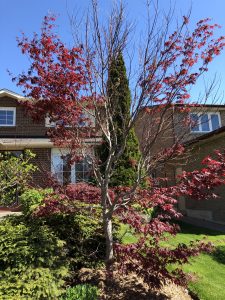
I have a Bloodgood Japanese Maple in a south facing location that was planted 6 years ago. It has done so well and looked beautiful and full until this spring when many of the branches remained bare. I went to a highly regarded garden centre to ask for advice and they recommended the Parkwood 20-20-20 all purpose fertilizer which I applied. Somehow I feel that there is more that I could do and I would greatly appreciate any advice you may have for me.
I live in Thornhill just north of Toronto and the soil is clay. I love this tree and I really hope that there is something I can do.
I look forward to hearing from you.
Thank you
Thank you for your inquiry. Japanese maples are true aristocrats among trees and people according Michael Dirr in Dirr’s Encyclopedia of Trees and Shrubs. Soils should be evenly moist, acid, organic laden and well drained. ‘Bloodgood’ is among the most cold hardy and is a slow growing, small tree maturing in the 15-20 ft. range. But because Japanese maples leaf out early in spring, they can be badly damaged by a late-spring frost.
It has been a very cold Spring and many trees have been affected. Firstly, you should protect your tree from wind and spring frosts. Perhaps the young foliage which is sensitive to cold may have been lost due to frost. You haven’t mentioned if there is any bud growth on the bare branches. I wasn’t able to clearly see the extent of the damage. Japanese maples do prefer a dappled shade location and the southerly exposure may be a bit too much exposure.
It might be worthwhile to have a tree expert examine the tree and recommend what to do. To find a certified professional arborist to help you with a tree problem, visit the Ontario branch of the International Society of Arboriculture here
The following information from one of our earlier posts:
“Japanese maples are quite vulnerable to cold temperatures, particularly when the tree has already begun to produce new growth in the early spring, and particularly in younger trees which may not yet be fully established. Damage from freezing appears as shrivelling or browning of foliage, and can also include branch die back. To find out whether your bare branches are viable, gently scrape the bark of these bare branches with your fingernail, starting at the tip and working back towards the base of the tree: you are hoping to find green, healthy wood below the bark. If you do find any green wood, prune the tree back to that point.
If you are certain that your branches are dead, they should be pruned out by cutting them back to the main branch or stem, being careful not to leave any stubs. Japanese maples will typically produce an abundance of weaker new shoots in response to freezing, and these will need to be managed by careful pruning so that the tree retains an attractive form. Here are links to articles that I hope will be helpful in identifying the damage that has been done, and managing it. The second also cautions on the excessive or wrongly-timed use of nitrogen fertilizers, which is something to be aware of. Because these fertilizers promote leaf growth, application at the wrong time may leave your tree even more vulnerable to damage from late freezes”:
https://homeguides.sfgate.com/japanese-red-maple-freeze-damage-35656.html
https://ipm.missouri.edu/MEG/2008/3/Caring-for-Freeze-Damaged-Japanese-Maples/

